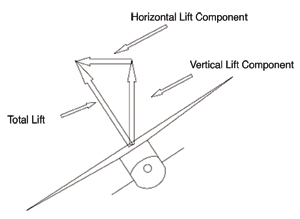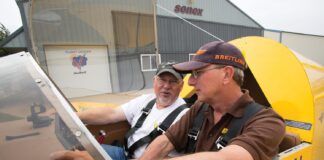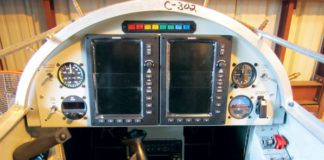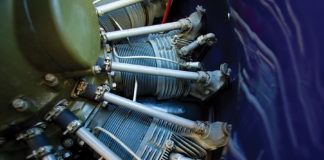A turn is one of the most basic flight maneuvers, but what really happens in turning flight is often misunderstood. Although it appears simple, an airplanes turn is a three-dimensional, three-axis maneuver.
The Physics of Turns
The velocity of an object is a vector quantity; it has both a magnitude and a direction. An acceleration is a change in velocity, and can be a change in either or both the direction of the velocity or its magnitude. A turning airplane is continuously accelerating toward the center of the turn even though its speed, which is the magnitude of the velocity, is constant. Newton tells us that a force must act on a mass to cause acceleration. In the case of a turning airplane, this force is the lift of the wings. By banking the airplane, the pilot aims some of the lift horizontally in the direction of the desired turn, and it is this component of the lift that curves the flight path in the direction of the bank.
Bank Angle | Load Factor |
|---|---|
10 | 1.015 |
20 | 1.064 |
30 | 1.15 |
40 | 1.305 |
50 | 1.556 |
60 | 2.0 |
70 | 2.924 |
80 | 5.76 |
Table 1: Effect of bank angle on load factor.
While the horizontal component of the lift is curving the flight path, the vertical component is still holding the airplane up against gravity. In a level turn, the vertical lift component must equal the weight of the airplane. The total lift required to perform the turn is the vector sum of the horizontal and vertical lift components. As we can see in Figure 1, the total lift in any level turn is greater than the weight of the airplane. As bank angle increases, the horizontal component of lift gets larger in relation to the vertical component. The vertical lift component is constant, so the total lift required increases with increasing bank angle.
The load factor or G load of the airplane is the total lift divided by the weight of the airplane. It is in units of gravity or G. In a constant-altitude turn, the load factor is given by:
N = 1/(cosine(bank angle))
N = Load factor in G.
Table 1 shows the influence of bank angle on the load factor required to maintain a level turn. As bank angle increases, the rate of load factor also increases. Going from zero bank to 10 increases load factor by only 0.015 G. Adding 10 of bank to go from 70 to 80 increases load factor by 2.84 G.
How Mishaps Happen
This phenomenon is a key ingredient in the classic stall/spin on base-to-final turn scenario. To increase load factor, the lift generated by the wing must increase. To increase lift, the pilot pulls back on the stick, increasing the angle of attack of the airplane. As we have just seen, the amount of extra lift required by a given bank angle increase is much larger if the airplane is already in a steep bank than it would be in a more gentle turn. This may catch the pilot by surprise if he is used to shallower turns. At the low airspeed typical in the pattern, the wing cannot develop enough lift to maintain the required load factor and will stall as the pilot attempts to increase lift by pulling back on the stick.

Figure 1. In a turn, part of the lift is directed horizontally by banking the airplane. The vertical component of the lift supports the weight of the airplane.
Another type of mishap occurs if the pilot increases bank angle but does not trim the airplane to a higher angle of attack. By increasing bank angle at a constant total lift, the pilot increases the horizontal component of lift, but decreases the vertical component. The vertical lift component is now less than the weight of the airplane, and gravity is always there. The airplane will start to accelerate down, and the flight path will curve toward the ground. If the initial bank angle is small, this descent will be slow and easily corrected.
In a steep turn near the ground the situation can get out of hand quickly. For example, suppose the airplane is in a steady 2 G (60 bank) turn, and the pilot increases the bank to 70 without increasing angle of attack. The vertical component of lift, which was equal to the weight of the airplane at 60 bank is now only 68% of the weight. The airplane accelerates down at 0.32 G. In one second the descent rate rises to 618 feet per minute. In the first second of over-banking the airplane loses 5 feet of altitude. In 5 seconds the altitude loss is 128 feet, and the airplane is descending at more than 3000 feet per minute (51.5 feet per second). Increasing the over-bank will rapidly make this situation worse. To recover, the pilot must decrease bank angle and pull in order to curve the flight path up, away from the ground.
Where over-banking typically gets pilots in trouble is in situations where they are looking at an object on the ground as they fly past it in a steep turn. One such situation occurs when a strike aircraft is pulling off the target after a bomb run. It is typical to turn hard to evade anti-aircraft fire. The pilot will also tend to keep looking at the target to see where the bomb hit. Civilian pilots can get into similar situations when they turn hard after a low pass, or are circling and concentrating on something on the ground rather than paying close attention to flying the airplane.
A pilot looking over the side in a steep turn cannot judge bank angle or descent rate very well. It is easy to over-bank when trying to keep sight of the ground target, inadvertently setting up a high descent rate situation. By the time the pilot becomes aware of the descent rate it may be too late to pull out. The way to avoid this type of situation is to look forward during a low-altitude turn, and follow your nose. When looking forward, the pilot will see the nose drop and the descent rate develop as soon as over-banking begins, and will naturally compensate to keep the airplane aimed away from the ground.
Control Aerodynamics
To initiate a turn the pilot must aim some of the lift in the direction of the desired turn. This is accomplished by rolling the airplane into a bank with the ailerons. The elevator has two tasks in the turn. As we have just seen, in the turn the total lift must be greater than the weight of the airplane. As the bank is established, the pilot must also pull on the stick and trim the airplane to a higher angle of attack to increase the lift as required.
As the airplane flies, the turn it is rotating about an axis normal to the plane of the turn. Because the aircraft is banked relative to this plane, this rotation is part pitch and part yaw. Accordingly, the airplane will have a constant, non-zero pitch and yaw rate while turning. The lift of the banked wing curves the flight path, but it does not produce moments to generate the required pitch and yaw rates. This is the job of the elevators and rudder. The elevators, in addition to trimming the airplane to the angle of attack required to generate enough lift for the turn, must also provide enough pitching moment to drive the required pitch rate. The role of the rudder and vertical fin is to provide the yaw rate necessary to keep the airplane pointed along the flight path. The rudder is also used to counteract the adverse yaw that is encountered when rolling into and out of a turn.
Adverse Yaw
When the stick is pushed laterally to initiate a turn, the pilot is attempting to command a pure rolling motion of the airplane. Unfortunately, the aerodynamics of the airplane are uncooperative, and deflecting the ailerons will often cause yaw as well as roll. For most airplanes, this yaw is in a sense opposite to that of the roll. If the stick is pushed to the left, the airplane will roll left-wing-down and yaw nose-right. This phenomenon is called adverse yaw because the yaw is in the opposite direction to the desired turn.
Several effects contribute. First, deflecting a simple aileron down usually increases the parasite drag of a wing more than deflecting the same aileron up an equal amount. If the ailerons are deflected equal and opposite amounts, the parasite drag of the wing with the down-deflected aileron will be higher than that of the wing with the up-deflected aileron.
The second effect contributing to adverse yaw is the change in induced drag between the two wings. In trying to roll the airplane, the pilot is increasing the lift of the wing he wishes to raise and decreasing the lift of the opposite wing. The lift increase on the rising wing increases its induced drag, while the lift decrease on the descending wing decreases its induced drag.
This induced drag difference occurs even when the mechanism for changing lift is not ailerons. The Wright brothers encountered adverse yaw on their early gliders, which had wing warping for lateral control. It was adverse yaw that led them to put a moveable rudder, geared to move simultaneously with the wing warp on their powered flyer. A similar effect has been observed on some radio-controlled model gliders, which change the incidence of the two wing panels for roll control.
Almost all airplanes exhibit some adverse yaw, though the severity varies dramatically from airplane to airplane. On some airplanes, particularly more modern ones, the adverse yaw is mild and the airplane can be turned, albeit sloppily, with the ailerons alone. On others, the adverse yaw can be so strong that without coordinated rudder deflections, the airplane cannot be turned at all. In a few extreme cases, the combination of high adverse yaw, large dihedral effect that resists the rolling moment of the ailerons, and low directional stability result in a situation where the airplane will respond to a stick deflection by turning opposite to the commanded roll unless the turn is coordinated with rudder.
Lessening the Effects of Adverse Yaw
In general, large-span, slow-flying airplanes such as gliders and ultralights experience more severe adverse yaw than shorter-span, faster-flying machines. The airplane designer has several approaches available to minimize the problems caused by adverse yaw. The earliest approach was simply to provide the pilot with enough rudder control power to overcome adverse yaw. As long as the pilot used plenty of rudder to coordinate turns, the airplane remained manageable and maneuverable.
Another approach is to couple the rudder to the ailerons with a spring called an aileron-rudder interconnect or ARI. The ARI spring helps the pilot deflect the rudder, reducing the rudder pressure required to coordinate the turn.
Aileron-rudder interconnect springs are sometimes installed in airplanes to make them respond to rudder as though they had more dihedral. When the pilot pushes on a rudder pedal, the ARI also deflects the ailerons, causing the airplane to roll in the direction of the yaw. It is an FAA requirement for certified airplanes that the pilot be able to control the airplane laterally and directionally with just the rudder pedals or just the stick. If the airplane has too little dihedral or too much adverse yaw, ARI can help it meet this requirement. Aileron-rudder interconnects can be helpful, but they can also be annoying, particularly if the pilot wishes to slip the airplane and must fight not only the aerodynamic hinge moment of the rudder, but also the ARI spring to deflect the rudder and hold the airplane in the slip.
As the state of the art in aerodynamics advanced, designers learned that there are other ways to reduce the pilots need to continuously counter adverse yaw when maneuvering the airplane. The first of these is to increase the directional stability of the airplane. Increasing the weathercock stability of the airplane reduces the amount it will yaw in response to a given yawing moment, such as that generated by the ailerons. Modern airplanes are much more stable directionally than early ones, hence yaw is much less in the same situation.
In addition to making airplanes more stable directionally, aerodynamicists and designers have devoted considerable attention to designing ailerons that do not produce as much adverse yaw. The earliest approach to this, and one which is still in use today, is called aileron differential. The aileron linkage is designed so that the up-going aileron deflects up more than the down-going aileron deflects down in response to a stick motion. Another approach to adverse-yaw reduction is to design the ailerons so that deflecting the aileron up increases its drag more than deflecting it down the same amount.
The combination of sufficient directional stability and better aileron design has reduced the problem of adverse yaw considerably. On modern light airplanes, it is possible to maneuver the airplane without touching the rudder pedals, though this is still not recommended pilot technique, and the turns produced will be uncoordinated.
Directional Stability
Even with good low-adverse-yaw ailerons, an airplane must have adequate directional (weathercock) stability to have good lateral/directional flying qualities. If directional stability is weak, the airplane will require a lot of rudder work to coordinate turns. A lack of directional stability may also make the airplane sensitive to rudder inputs. This combination will make lateral/directional control tasks difficult for the pilot.
Lack of sufficient vertical fin is a common failing of homebuilt airplanes and kit aircraft. Designers tend to make the fin too small in an attempt to reduce drag or weight. Often the airplane ends up with lateral/directional flying qualities that are at best adequate, and would be much improved by an increase in directional stability. Kit manufacturers are starting to realize this and modify their products to improve directional stability. This trend is one component of a most welcome increase in recognition of the value of good overall flying qualities in the kit aircraft business.
Barnaby Wainfan is a principal aerodynamics engineer for Northrop Grummans Advanced Design organization. A private pilot with single engine and glider ratings, Barnaby has been involved in the design of unconventional airplanes including canards, joined wings, flying wings and some too strange to fall into any known category.













